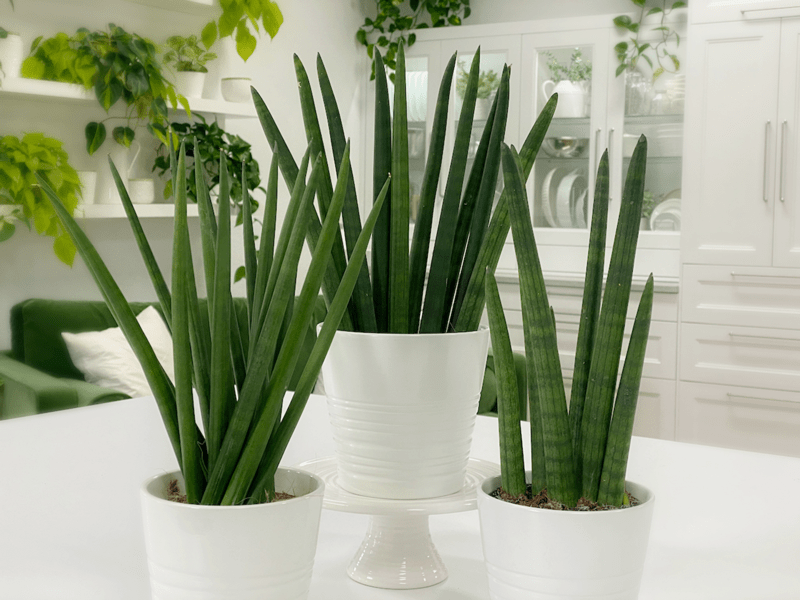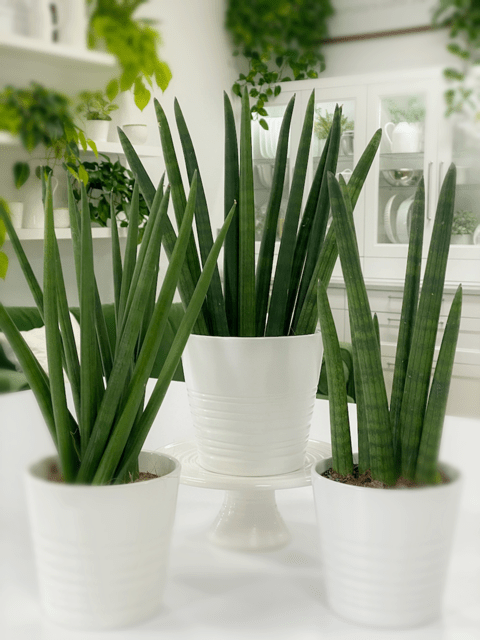

 Add to favorites
Add to favorites
Every houseplant goes by many different names. I like to keep things simple and stick to common names (they are easier for me to remember) but if you want to get all fancy, you can also refer to the snake plant as African spear, skyline spear, cylindrical mother-in-law’s tongue, spear orchid, spear plant, or spear sansevieria. No wonder people get confused when they’re new to plant-parenthood!

If you lean toward a modern, minimalistic alien vibe when decorating, this plant is for you! Its tubular, smooth leaves are dark green in color, some with green-grey variegation, and make for a real attention-grabber. Each cylindrical tube grows to about 1.5″ thick and up to 7 feet tall! Sansevieria cylindrica is related to the snake plant and is easy to care for. You can find these plants braided, clumped together in the center of a pot, and the stalks might be fanned out. If you find some that look wavy, that’s because it was once braided.
Easy does it with the watering. You want to be careful not to overdo it, because your plant will rot out. Always make sure the soil is almost completely dry before thoroughly watering again. Size and location depending, you will end up watering your Snake Plants every 2-6 weeks. If you travel or tend to ignore plants, this is the one for you. But don’t ignore them TOO long, nobody really likes to be ignored; human or plant.
Even though Sansevierias prefer medium light, they’ll also tolerate low light and high light. The main thing you need to watch for is DIRECT sunlight. No houseplant does well in those conditions, because the leaves can burn. So, as you can see, this plant gives you many options when it comes to placement.
Sansevierias will tolerate a wide range of temperatures, between 55 – 85 degrees (F). Temperatures below 55 degrees (F) can cause them harm.
Fertilizer isn’t necessary but may encourage brighter colors and faster growth. You can feed the plant once a month spring through fall with a diluted fertilizer that is specially made for succulents. Skip feeding during winter, when the growth is slow.
 Plant Characteristics to Watch For
Plant Characteristics to Watch ForDiagnosing what is going wrong with your plant is going to take a little detective work and even more, patience! First of all, don’t panic and don’t throw a plant out prematurely. Take a few deep breaths and work down the list of possible issues.
Below, I am going to share some typical symptoms that can arise. When I start to spot troubling signs on a plant, I take the plant into a room with good lighting, pull out my magnifiers, and begin by thoroughly inspecting the plant.
If you want to have healthy house plants, you MUST inspect them regularly. Every time I water a plant, I give it a quick look-over. Bugs/insects feeding on your plants reduces the plant sap and redirects nutrients from leaves. Snake plants are highly pest-resistant, but in poor conditions, they can get mealybugs and/or spider mites. The biggest threat is fungal growth due to root rot. If the plant receives too much water or grows in soil with poor drainage, the fungus may start to appear near the base of the plant.
I came across one instance where I had little worm-like bugs at the bottom of the cover pot. These creatures made their way through the soil and out one of the drain holes. In this case, I made up a hydrogen peroxide solution and poured it through the soil, making sure to saturate it. You can read about it (here).
While the toxicity levels are low, it’s safest to keep pets away from your plant. It can cause excessive salivation, pain, nausea, vomiting, and diarrhea.
Thank you, seems to answer my question